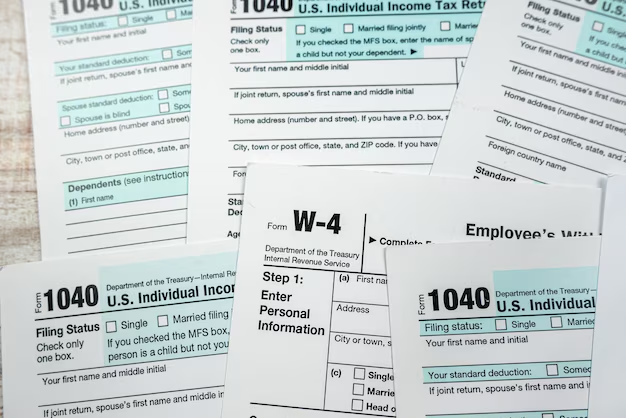Understanding IRS Form 1040: Your Comprehensive Guide to America's Most Common Tax Form
Filing taxes might feel like a daunting task, but understanding the right forms can simplify your journey through tax season. Among these forms, IRS Form 1040 is central to most taxpayers in the United States. Whether you're a tax novice or someone looking to refresh your knowledge, this guide is here to help you understand what the IRS Form 1040 is, how it's used, and what you need to know about it.
🤔 What is IRS Form 1040?
IRS Form 1040 is the standard federal income tax form used to report an individual’s gross income. Essentially, it's the document the Internal Revenue Service (IRS) requires to calculate how much you owe in taxes or what you might receive as a refund.
Key Features of Form 1040
- Reports Income: Lists all your earned income, including wages, salaries, and other taxable income sources.
- Tax Calculation: Helps in determining your tax liability after deductions, credits, and other adjustments.
- Taxpayer Information: Includes fields for personal details such as personal identification, filing status, and dependents.
🗂️ Different Variants of Form 1040
To meet varied personal and financial situations, the IRS offers several versions of Form 1040:
1. 1040EZ (No Longer Available)
Once a simpler version of the form for those with straightforward tax situations, 1040EZ was discontinued in 2018.
2. 1040A (No Longer Available)
This form was also discontinued and merged into the broader 1040 to simplify the process.
3. Standard 1040
The main form used today, suitable for most tax scenarios.
4. 1040-SR
Introduced for seniors, this form offers larger print and a standard deduction chart for those over 65.
🔍 How to Fill Out Form 1040
Completing Form 1040 can be straightforward if you break it down into manageable steps:
Gathering Necessary Documents
Before starting, make sure you have:
- W-2 Forms: From your employer, showing your earnings and taxes withheld.
- 1099 Forms: For any freelance or contract work.
- Other Income Statements: Such as interest or dividend income.
Instructions for Filing
- Personal Information: Start by entering your name, Social Security number, and address.
- Filing Status: Choose your appropriate filing status—Single, Married Filing Jointly, etc.
- Income Reporting: List all income types, including wages and dividends.
- Deductions and Credits: Enter any eligible deductions like student loan interest or educational credits.
- Determine Taxable Income: Subtract deductions from your gross income.
- Calculate Taxes Owed or Refund Due: Use the tax table to ascertain the tax liability or refund amount.
📝 Quick Tips for Accuracy
- Always double-check your entries for mistakes.
- Use online IRS tools or tax preparation software to e-file if possible.
- Ensure all personal details exactly match IRS records.
🎯 Common Questions About Form 1040
Who Needs to File Form 1040?
Almost everyone making over the minimum income threshold should file this form. However, specifics can vary based on filing status and age.
What Are Common Deductions and Credits?
Popular ones include:
- Standard Deduction: Varies based on filing status.
- Itemized Deductions: For mortgage interest, medical expenses, etc.
- Credits: Such as Child Tax Credit or Education Credits.
When is Form 1040 Due?
Generally due by April 15th each year, though extensions are available with Form 4868.
📊 Visual Summary of Key Points
| Topic | Key Takeaways |
|---|---|
| Form Purpose | Used to report personal income and calculate tax liability or refund. |
| Different Types | Standard 1040, now includes previous 1040EZ and 1040A features; 1040-SR for seniors. |
| Filing Tips | Gather all financial documents; choose correct filing status; ensure accuracy in inputs. |
| Deadline | Due April 15th; extensions possible. |
🔄 Improving Your Tax Filing Experience
Consider Professional Help
If your tax situation is complicated with multiple income streams, consider consulting a tax professional. This ensures:
- Accuracy in Reporting: Professionals can help you avoid costly errors.
- Maximization of Benefits: Ensures you claim all eligible deductions and credits.
Utilize Tax Software
Today’s tax software automates much of the process and provides user-friendly guidance, reducing the stress of form filling.
Stay Informed on Tax Laws
Tax laws can change. Keeping up-to-date with current rules helps you make informed decisions that could save money and time.
🚀 Empowering Financial Literacy
Understanding IRS Form 1040 is more than just an annual must-do—it's a step towards improved financial literacy. By knowing how to properly complete this form, you gain control over your financial destiny, ensuring compliance and possibly minimizing your tax burden.
By breaking down the complexity of tax filing into digestible steps, you can approach tax season with confidence rather than dread. Taking the time to familiarize yourself with these forms and procedures is an investment in your financial well-being.
Hopefully, this guide has demystified Form 1040 for you, providing clarity and valuable insights for the tax filing process. Armed with this knowledge, you can navigate tax season with assurance and ease.
